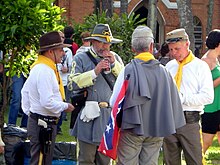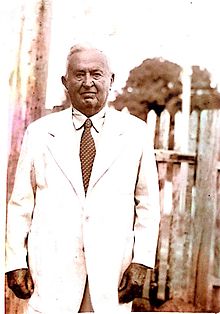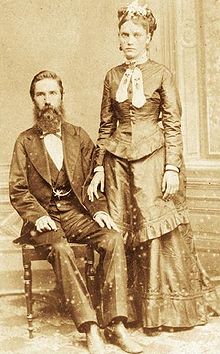
Confederados is the Brazilian name for Confederate expatriates, all white Southerners, who fled the Southern United States during Reconstruction, and their Brazilian descendants. They were enticed to Brazil by offers of cheap land from Emperor Dom Pedro II, who had hoped to gain expertise in cotton farming. The regime in Brazil had a number of features that attracted the Confederados, among these political decentralization, and a relatively high commitment to free trade. The continuing legality of slavery was another factor, though few Confederados actually acquired slaves in Brazil.

Americana is a municipality (município) located in the Brazilian state of São Paulo. It is part of the Metropolitan Region of Campinas. The population is 237,240 in an area of 133.91 km2 (51.70 sq mi). The original settlement developed around the local railway station, founded in 1875, and the development of a cotton weaving factory in a nearby farm.
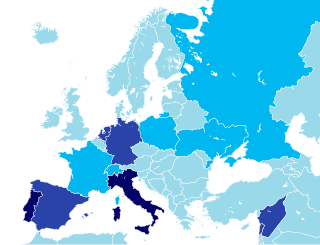
Immigration to Brazil is the movement to Brazil of foreign peoples to reside permanently. It should not be confused with the forcible bringing of people from Africa as slaves. Latin Europe accounted for four-fifths of the arrivals. This engendered a strikingly multicultural society. Yet over a few generations, Brazil absorbed these new populations in a manner that resembles the experience of the rest of the New World.
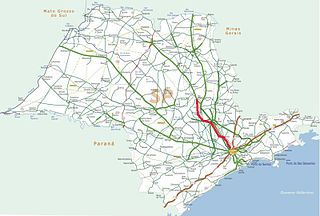
The Rodovia Bandeirantes is a highway in the state of São Paulo, Brazil.
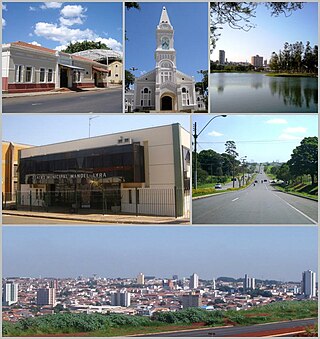
Santa Bárbara d'Oeste is a municipality in the State of São Paulo in Brazil. It is part of the Metropolitan Region of Campinas. It lies about 138 kilometres (86 mi) northwest of the State capital. It occupies an area of 272.2 square kilometres (105.1 sq mi), of which 43.1 square kilometres (16.6 sq mi) is urban. In 2020, the population was estimated at 194,390 by the Brazilian Institute of Geography and Statistics, making it the 43rd most populous city in São Paulo and the sixth largest in the metropolitan region of Campinas.

White Brazilians refers to Brazilian citizens who are considered or self-identify as "white", typically because of European or Levantine ancestry.
Amazonian Jews are the Jews of the Amazon basin, mainly descendants of Moroccan Jews who migrated to northern Brazil and Peru in the 19th and early 20th centuries. The migrants were attracted to the growing trade in the Amazon region, especially during the rubber boom, as well as to the newly established religious tolerance. They settled in localities along the Amazon River, such as Belém, Cametá, Santarém, Óbidos, Parintins, Itacoatiara and Manaus in Brazil, some venturing as far as Iquitos in Peru.
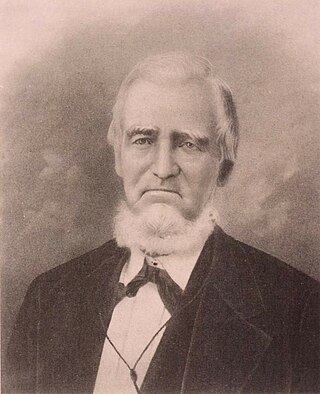
William Hutchinson Norris was an American politician who was the founder of the city of Americana and a settlement in Santa Bárbara d'Oeste. A notable Confederate during American Civil War, Norris was a significant figure in the history of the Confederados following the war.

Russian Brazilians are Brazilian citizens of full or partial Russian ethnic background or Russian-born people residing in Brazil. The term can also refer to someone with a Brazilian mother and Russian father, or vice versa.

Confederate colonies were made up of Confederate refugees who were displaced or fled their homes during or immediately after the American Civil War. They migrated to various countries, but especially Brazil, where slavery remained legal, and to a lesser extent Mexico and British Honduras.

The Piracicaba River is a river of São Paulo state in southeastern Brazil. It is a tributary of the Tietê River, which it joins in the reservoir created by Barra Bonita Dam. There is also another Piracicaba river in the state of Minas Gerais, named after the one from São Paulo state, since the early colonizers of Minas Gerais largely came from São Paulo.

The Tietê Bus Terminal is the largest bus terminal in Latin America, and the second largest in the world, after the Port Authority Bus Terminal in New York City. The terminal is located in the Santana district in the city of São Paulo, Brazil. The official name in Portuguese is Terminal Rodoviário Governador Carvalho Pinto, named after Carlos Alberto Alves de Carvalho Pinto, a former Governor of the State of São Paulo.
The Brazilian municipal elections of 2012 took place on October 7 and on October 28. Over 138 million voters chose mayors, deputy mayors and city councillors for the 5,568 municipalities of Brazil. These were the first elections in which the recently registered parties Partido Pátria Livre (PPL) and Partido Social Democrático (PSD) participated; they were both recognized by the Superior Electoral Court in 2011. Political parties whose candidates wished to run for the 2012 elections had to be registered at the TSE for at least one year before the election date, while candidates also had to be affiliated to a party for the same period of time. Conventions for the selection of candidates within the parties occurred between 10 and 30 June, while the registry of candidates and alliances with the Regional Electoral Courts took place until July 5. Electoral campaign was authorized from the moment a candidacy had been registered. The free electoral program – two daily slots on free-to-air TV and radio for political advertising paid by the Electoral Justice fund – ran weekdays from 21 August until 4 October. According to the current Brazilian electoral law, the two-round system – should the leading candidate receive less than 50% +1 of the votes – is only available for cities with more than 200,000 voters. This includes all state capitals, with the exception of Boa Vista, Roraima and Palmas, Tocantins, plus 59 other municipalities. The free electoral program for the second round ran from 13 October until 26 October.

The São Paulo Macrometropolis or São Paulo Megalopolis, also known as Expanded Metropolitan Complex, is a Brazilian megalopolis that emerged through the existing process of conurbation between the São Paulo's metropolitan areas located around the Greater São Paulo, with more than 30 million inhabitants, or 74 percent of São Paulo State's population, and is one of the most populous urban agglomerations in the world.

Events in the year 1893 in Brazil.
Jacob Philip Wingerter was a Protestant colporteur evangelist who spent most of his life campaigning for the Presbyterian church in Brazil.

The Metropolitan Region of Campinas is an administrative division of the state of São Paulo in Brazil. It was created in 2000, and consists of the following municipalities:
Pérola Ellis Byington was a Brazilian philanthropist and social activist. She was an advocate for mother and children's health assistance in Brazil during the first half of 20th century.
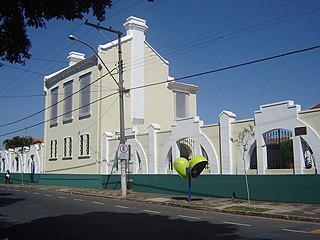
The Immigration Museum is a public museum located in the city of Santa Bárbara d'Oeste, in the countryside of the state of São Paulo, Brazil. It was founded on January 30, 1988, from the collection of the Fraternity of American Descendants, a civil society organization responsible for managing the Cemetery of the Americans. It is subordinated to the Municipal Secretariat of Culture and Tourism.
Festa dos Confederados is a festival which takes place at the end of April in Santa Barbara, d'Oeste in the state of São Paulo, Brazil. The festival commemorates the history of the Confederados, who were a group of Confederate soldiers fleeing to Brazil to continue practicing slavery after the defeat of the Confederate States of America following the American Civil War, as Brazil was one of the last countries to legally bar slavery. As years have passed, there has been an increase in contention around the holiday as Americans see the symbol of the Confederate flag as a symbol of historical racism, and Brazilian Confederados see it as something that connects them to their ancestors.
